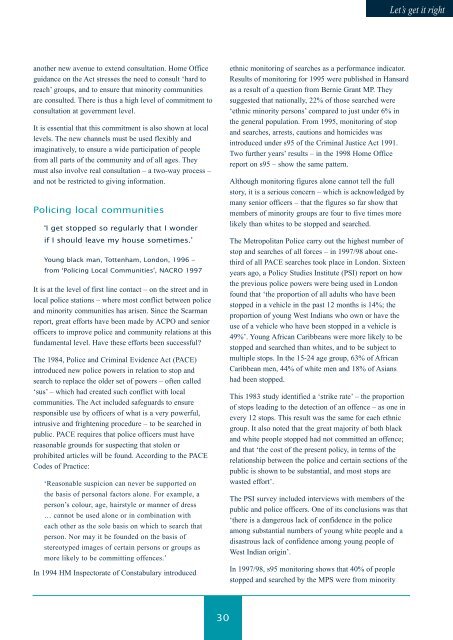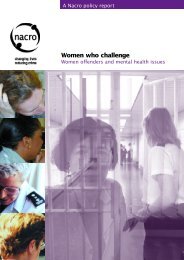Let's get it right: race and justice 2000 - Nacro
Let's get it right: race and justice 2000 - Nacro
Let's get it right: race and justice 2000 - Nacro
- No tags were found...
You also want an ePaper? Increase the reach of your titles
YUMPU automatically turns print PDFs into web optimized ePapers that Google loves.
Let’s <strong>get</strong> <strong>it</strong> <strong>right</strong>another new avenue to extend consultation. Home Officeguidance on the Act stresses the need to consult ‘hard toreach’ groups, <strong>and</strong> to ensure that minor<strong>it</strong>y commun<strong>it</strong>iesare consulted. There is thus a high level of comm<strong>it</strong>ment toconsultation at government level.It is essential that this comm<strong>it</strong>ment is also shown at locallevels. The new channels must be used flexibly <strong>and</strong>imaginatively, to ensure a wide participation of peoplefrom all parts of the commun<strong>it</strong>y <strong>and</strong> of all ages. Theymust also involve real consultation – a two-way process –<strong>and</strong> not be restricted to giving information.Policing local commun<strong>it</strong>ies‘I <strong>get</strong> stopped so regularly that I wonderif I should leave my house sometimes.’Young black man, Tottenham, London, 1996 –from ‘Policing Local Commun<strong>it</strong>ies’, NACRO 1997It is at the level of first line contact – on the street <strong>and</strong> inlocal police stations – where most conflict between police<strong>and</strong> minor<strong>it</strong>y commun<strong>it</strong>ies has arisen. Since the Scarmanreport, great efforts have been made by ACPO <strong>and</strong> seniorofficers to improve police <strong>and</strong> commun<strong>it</strong>y relations at thisfundamental level. Have these efforts been successful?The 1984, Police <strong>and</strong> Criminal Evidence Act (PACE)introduced new police powers in relation to stop <strong>and</strong>search to replace the older set of powers – often called‘sus’ – which had created such conflict w<strong>it</strong>h localcommun<strong>it</strong>ies. The Act included safeguards to ensureresponsible use by officers of what is a very powerful,intrusive <strong>and</strong> f<strong>right</strong>ening procedure – to be searched inpublic. PACE requires that police officers must havereasonable grounds for suspecting that stolen orprohib<strong>it</strong>ed articles will be found. According to the PACECodes of Practice:‘Reasonable suspicion can never be supported onthe basis of personal factors alone. For example, aperson’s colour, age, hairstyle or manner of dress… cannot be used alone or in combination w<strong>it</strong>heach other as the sole basis on which to search thatperson. Nor may <strong>it</strong> be founded on the basis ofstereotyped images of certain persons or groups asmore likely to be comm<strong>it</strong>ting offences.’In 1994 HM Inspectorate of Constabulary introducedethnic mon<strong>it</strong>oring of searches as a performance indicator.Results of mon<strong>it</strong>oring for 1995 were published in Hansardas a result of a question from Bernie Grant MP. Theysuggested that nationally, 22% of those searched were‘ethnic minor<strong>it</strong>y persons’ compared to just under 6% inthe general population. From 1995, mon<strong>it</strong>oring of stop<strong>and</strong> searches, arrests, cautions <strong>and</strong> homicides wasintroduced under s95 of the Criminal Justice Act 1991.Two further years’ results – in the 1998 Home Officereport on s95 – show the same pattern.Although mon<strong>it</strong>oring figures alone cannot tell the fullstory, <strong>it</strong> is a serious concern – which is acknowledged bymany senior officers – that the figures so far show thatmembers of minor<strong>it</strong>y groups are four to five times morelikely than wh<strong>it</strong>es to be stopped <strong>and</strong> searched.The Metropol<strong>it</strong>an Police carry out the highest number ofstop <strong>and</strong> searches of all forces – in 1997/98 about onethirdof all PACE searches took place in London. Sixteenyears ago, a Policy Studies Inst<strong>it</strong>ute (PSI) report on howthe previous police powers were being used in Londonfound that ‘the proportion of all adults who have beenstopped in a vehicle in the past 12 months is 14%; theproportion of young West Indians who own or have theuse of a vehicle who have been stopped in a vehicle is49%’. Young African Caribbeans were more likely to bestopped <strong>and</strong> searched than wh<strong>it</strong>es, <strong>and</strong> to be subject tomultiple stops. In the 15-24 age group, 63% of AfricanCaribbean men, 44% of wh<strong>it</strong>e men <strong>and</strong> 18% of Asianshad been stopped.This 1983 study identified a ‘strike rate’ – the proportionof stops leading to the detection of an offence – as one inevery 12 stops. This result was the same for each ethnicgroup. It also noted that the great major<strong>it</strong>y of both black<strong>and</strong> wh<strong>it</strong>e people stopped had not comm<strong>it</strong>ted an offence;<strong>and</strong> that ‘the cost of the present policy, in terms of therelationship between the police <strong>and</strong> certain sections of thepublic is shown to be substantial, <strong>and</strong> most stops arewasted effort’.The PSI survey included interviews w<strong>it</strong>h members of thepublic <strong>and</strong> police officers. One of <strong>it</strong>s conclusions was that‘there is a dangerous lack of confidence in the policeamong substantial numbers of young wh<strong>it</strong>e people <strong>and</strong> adisastrous lack of confidence among young people ofWest Indian origin’.In 1997/98, s95 mon<strong>it</strong>oring shows that 40% of peoplestopped <strong>and</strong> searched by the MPS were from minor<strong>it</strong>y30

















